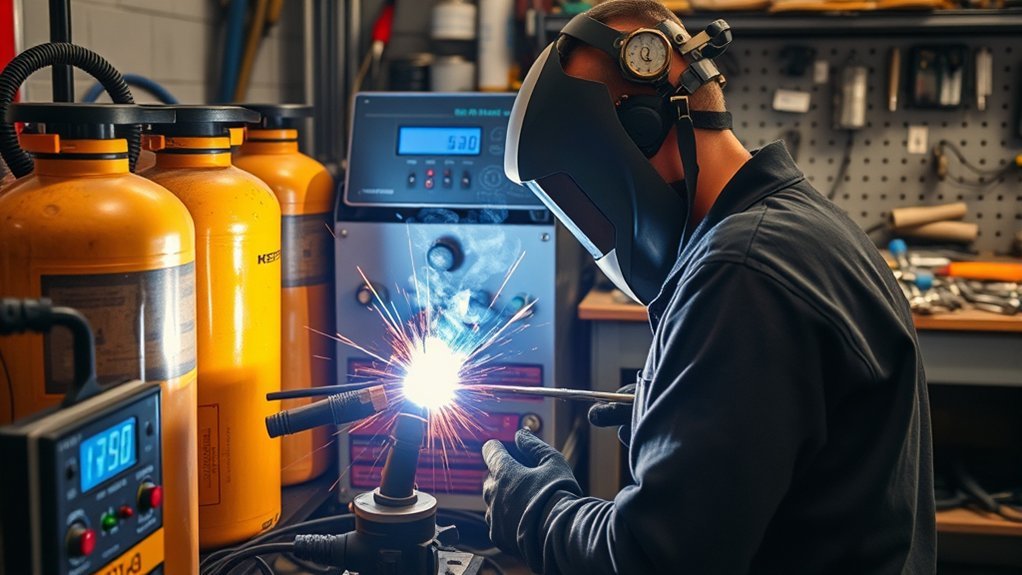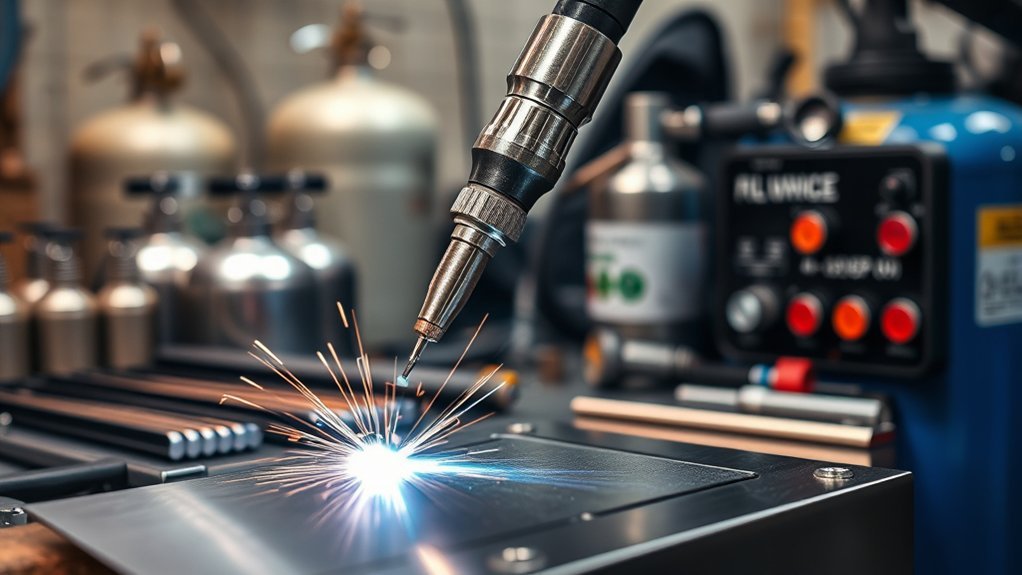TIG welding costs generally range from $75 to $125 per hour, depending on the complexity. Material expenses vary too. For example, stainless steel welding can cost between $1.00 to $3.50 per inch, while aluminum ranges from $1.25 to $4.00 per inch. You should also factor in additional costs for filler metals, shielding gases, and equipment maintenance, which could add about 10% to your total. Discover how different factors can further influence these prices.
Overview of TIG Welding Costs

When considering TIG welding, you’ll find that costs typically range from $75 to $125 per hour, reflecting the method’s high precision and control.
The price can vary based on material types; for instance, stainless steel costs between $1.00 to $3.50 per inch of weld, while aluminum ranges from $1.25 to $4.00 per inch.
The cost of TIG welding varies by material, with stainless steel priced from $1.00 to $3.50 per inch, and aluminum from $1.25 to $4.00.
Additionally, factor in costs for filler metals and shielding gases, which can add up to 10% of your total project expenses.
The complexity of your TIG welding job, including material thickness and accessibility, will also influence overall pricing.
Despite higher costs, the TIG welding benefits—such as producing strong, clean welds—make it ideal for applications in aerospace, automotive, and artistic metalwork.
Equipment and Setup Expenses

While investing in TIG welding equipment may seem challenging, understanding the associated costs can help you make informed decisions. Your basic setup typically ranges from $500 to $2,500, with advanced TIG welder types exceeding $5,000 for enhanced features.
Essential components include the TIG welder itself, often equipped with high-frequency start and pulse settings for precision. You’ll also need to account for setup variations, such as shielding gases like argon, costing around $40 to $50 per bottle.
Additionally, consumables like tungsten electrodes range from $10 to $50 per pack, and filler metals vary based on material type. Don’t forget to budget for regular maintenance and replacement parts, which are vital for long-term equipment upkeep.
Consumables and Operational Costs

Having established the foundational costs associated with TIG welding equipment, it’s important to contemplate the ongoing consumables and operational costs that can considerably impact your project budget.
TIG consumables pricing includes tungsten electrodes, ranging from $1 to $3 each, and filler metals like aluminum or stainless steel rods, costing between $5 and $20 per pound. Additionally, shielding gas, mainly argon, can run $40 to $50 per bottle, with consumption rates affecting refill frequency.
Other consumables, such as backing bars and gas lenses, may add $10 to $50. Don’t forget about maintenance expenses; cleaning and parts replacement can cost $100 to $300 annually, further influencing your overall operational budget.
Cost Factors Based on Project Scope

Understanding the cost factors based on project scope can greatly impact your budget for TIG welding.
Project complexity plays a significant role; intricate designs and thicker materials require more time and specialized skills, driving up labor costs.
Additionally, the metal types involved influence expenses. For instance, welding stainless steel and aluminum typically incurs higher charges due to their unique properties and the techniques needed to work with them effectively.
Don’t forget that consumables—like tungsten electrodes and filler metals—add another layer of cost, ranging from $30 to $100 per project.
Finally, investing in proper safety equipment and ventilation is essential for compliance and safety, further contributing to your overall project expenses.
Budgeting Tips for TIG Welding

When budgeting for TIG welding, it’s crucial to account for both direct and indirect costs to avoid surprises.
Start by considering labor rates, which typically range from $75 to $125 per hour. Next, factor in material costs, including filler metals and electrodes, adding approximately 10% to your total expenses.
Complex designs and materials can greatly impact costs; for instance, welding stainless steel can range from $1.00 to $3.50 per inch. Don’t overlook additional expenses like shielding gas refills and equipment maintenance.
To implement cost-saving strategies, simplify designs, choose mild steel over pricier options, and perform preparatory tasks yourself. Effective project planning will help guarantee your budget remains on track while achieving high-quality results.
Frequently Asked Questions
What Types of Materials Can Be Welded Using TIG Welding?
You can weld various materials using TIG welding, including aluminum alloys and stainless steel. This process provides excellent control and precision, making it suitable for projects requiring high-quality, durable welds in these materials.
How Long Does a Typical TIG Welding Project Take?
Your TIG welding project duration varies, typically ranging from a few hours to several days. Time estimation depends on factors like complexity, material type, and your skill level, ensuring precision and quality in every weld.
Can TIG Welding Be Done Outdoors?
Yes, you can perform TIG welding outdoors, but be aware of outdoor challenges like wind and moisture. However, the advantages of precision and control in TIG welding often outweigh these environmental obstacles when done correctly.
Is TIG Welding Suitable for Beginners?
Absolutely, TIG welding’s precision makes it suitable for beginners. However, you’ll need to practice TIG welding techniques to avoid common beginner mistakes, ensuring you create clean, strong welds while mastering this art form.
What Safety Gear Is Needed for TIG Welding?
For TIG welding, you need essential protective equipment like a welding helmet, gloves, flame-resistant clothing, and safety glasses. Prioritizing welding safety guarantees you’re safeguarded against hazards, keeping you protected while working effectively.
Conclusion
In conclusion, understanding TIG welding costs is essential for effective budgeting. Like a well-tuned machine, every component—from equipment to consumables—plays a significant role in your overall expenditure. By considering project scope and potential fluctuations, you can better navigate these expenses. Keep track of operational costs and invest wisely in quality equipment to guarantee your projects run smoothly. With careful planning, you can achieve exceptional results without breaking the bank.


